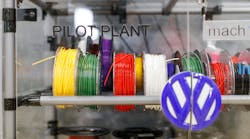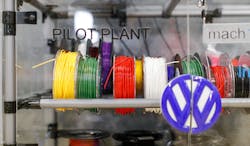Open Platform Turns Desktop 3D Printers into Industrial Machines
Over the course of a decade, myriad changes transform industries across the board, and 3D printing has certainly seen its share. Though 3D printing has never been short on innovation, only a small group of companies ran the show, namely 3D Systems, Stratasys, EOS, and EnvisionTEC. By essentially cornering the market and controlling the pace of innovation within a closed materials environment, this handful of companies put any hope of realistic competition out of reach for polymer and plastics companies, some of whom are order of magnitudes larger in size with vast materials expertise.
That is, until the emergence of platform materials.
Open-source or open-materials 3D printing is the concept whereby developers choose to open up access to hardware designs, software code, and materials formulations rather than keeping things secret or filing patents. The concept is that by having an open environment, more people will contribute, share, and thus move innovation more quickly. The broader community can benefit from this type of access and in turn improve the products.
Within 3D printing, the open environment has especially benefitted materials. As desktop platforms progressed toward being open, they enabled use of a much wider range of materials and multiple new companies were able to develop and create materials for fused-filament-fabrication (FFF) printers.
Open-materials 3D printing has expanded the range of filaments that can be used for professional desktop 3D printing.
Today, many companies embrace open materials in 3D printing and accelerated desktop printing capabilities by developing a variety of polymers for use in filament form. The emergence of carbon-filled as well as metal-powdered materials has also helped make desktop an intriguing option for many manufacturers.
Not too long ago, polylactic acid (PLA) was widely considered one of the only materials available for desktop 3D printers—now acrylonitrile butadiene styrene (ABS), polycarbonate, nylon, polypropylene, and flexible material are helping round out a selection that appeals to many more types of professional customers. Such a range of materials combined with more reliable machines and more accurate parts is bringing desktop 3D printers to the center stage of professional applications.
The Desktop Rage
Having the ability for stronger materials or higher-temperature materials has really extended the capability of the desktop platform. Outside of prototyping for fixtures, jigs, or tools, PLA just does not have the strength or endurance to keep up in a manufacturing environment. The improving quality of plastic 3D-printed parts is a somewhat recent phenomenon that has made these parts suitable for end-use applications.
In addition, inexpensive price points are largely attributed to the proliferation of open platform materials for desktop systems. While technical innovation continues to happen, increasing access through improved ease of use and cost reduction is the real promise for 3D printing.
Rather than choosing big, expensive machines, many manufacturers are instead implementing fleets of desktop 3D printers to meet prototyping and production demands. This is analogous to how some companies might prefer a cluster of computers or servers working in unison as opposed to a single supercomputer.
The VW manufacturing plant produced 1,000 tools last year using desktop 3D printers, including gauges, jigs, and fixtures.
Five years ago, the percentage of desktop 3D-printing units being sold in the enterprise space was basically zero. Now, desktop 3D printer manufacturers at the higher end of the sub-$5000 price range, enterprise customers represent more than 50% of sales volume. Expect more organizations to adopt the desktop approach in the coming years.
One example of desktop 3D printing being used at scale today can be found at Volkswagen Autoeuropa, a VW plant in Portugal that produces 100,000 cars per year and specializes in engineering innovations and new models. Using a group of desktop 3D printers, the VW manufacturing plant produced 1,000 tools last year—including gauges, jigs, and fixtures. Printing on-demand in the plant, as opposed to outsourcing, reduced tool development by 95%, and saved 90% in production costs. The ability to use a variety of materials to produce parts adds an extra layer of flexibility that would not be attainable in a closed environment.
Open-source and open materials have helped drive innovation in desktop 3D printing faster than what could have occurred if several small startups were acting on their own. Plastics companies with advanced expertise have now been enabled by this approach. This expertise, and the products that come from it, have helped elevate desktop 3D printing to the point of being technically competitive with more expensive closed systems—at a fraction of the cost.


